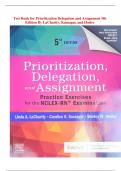Exam (elaborations)
Test Bank for Prioritization Delegation and Assignment 5th Edition LaCharity, Kumagai, and Hosler
- Course
- Institution
- Book
Test Bank for Prioritization Delegation and Assignment 5th Edition LaCharity, Kumagai, and Hosler
[Show more]



